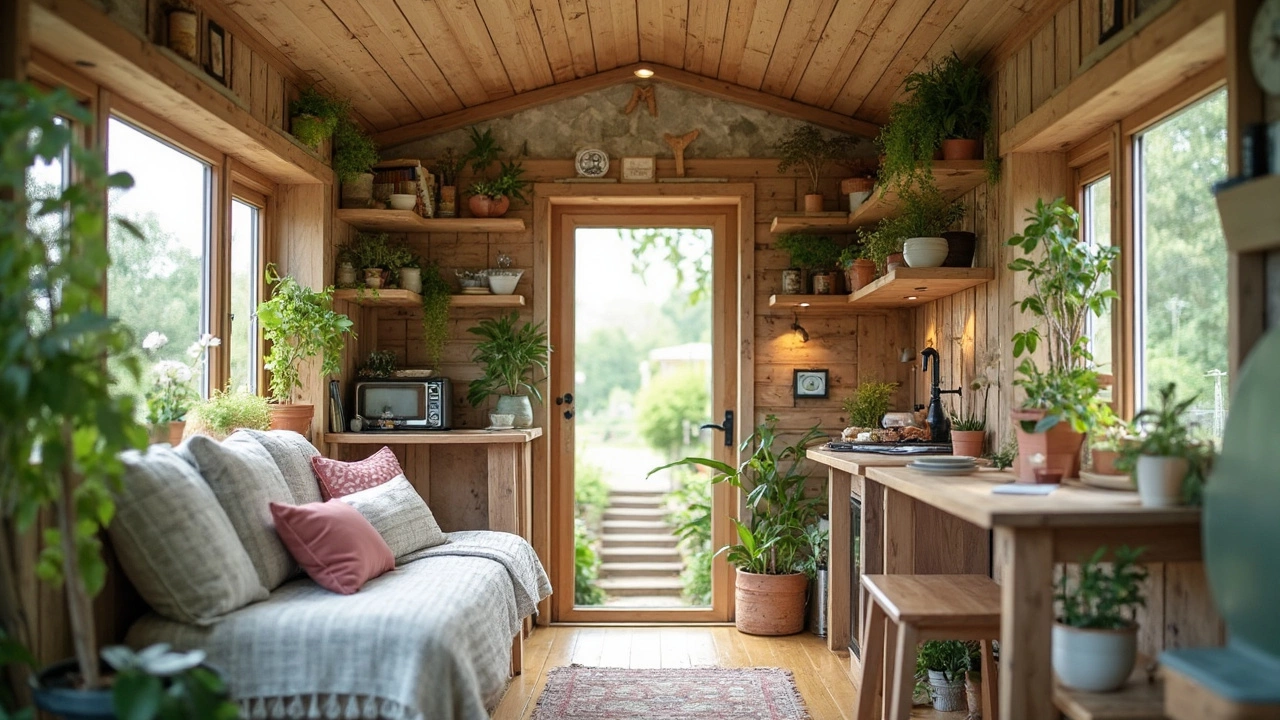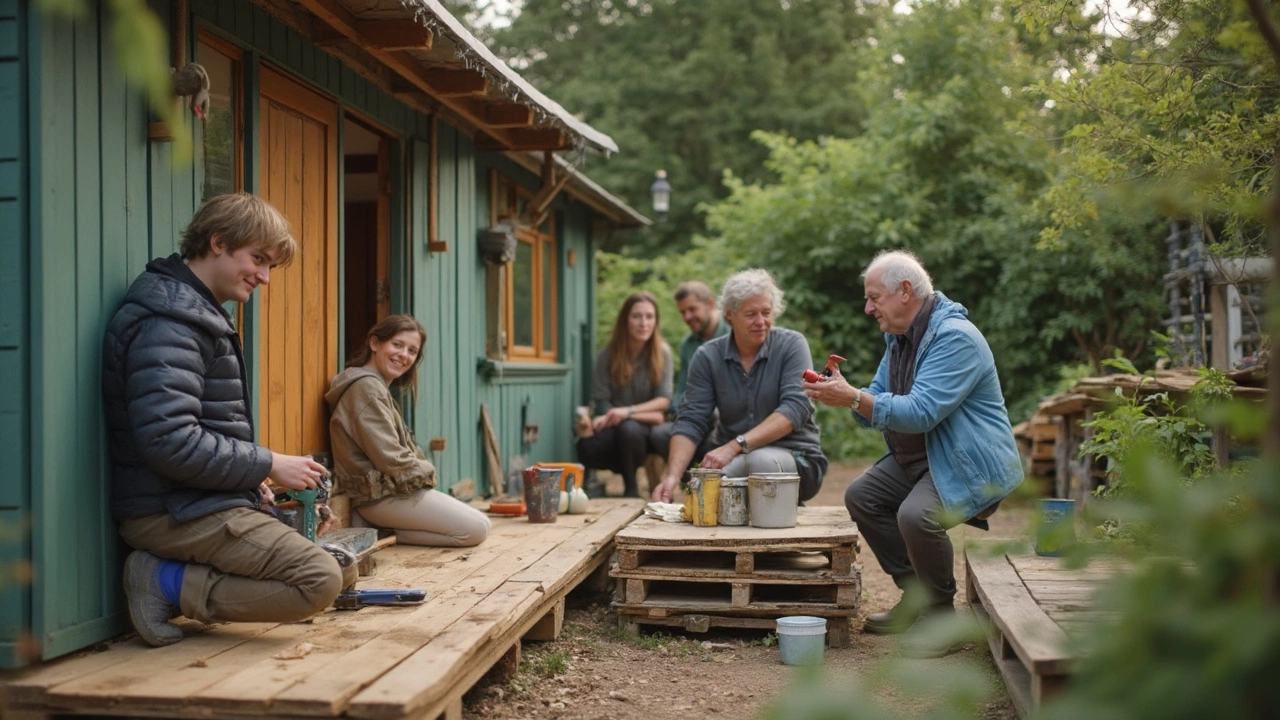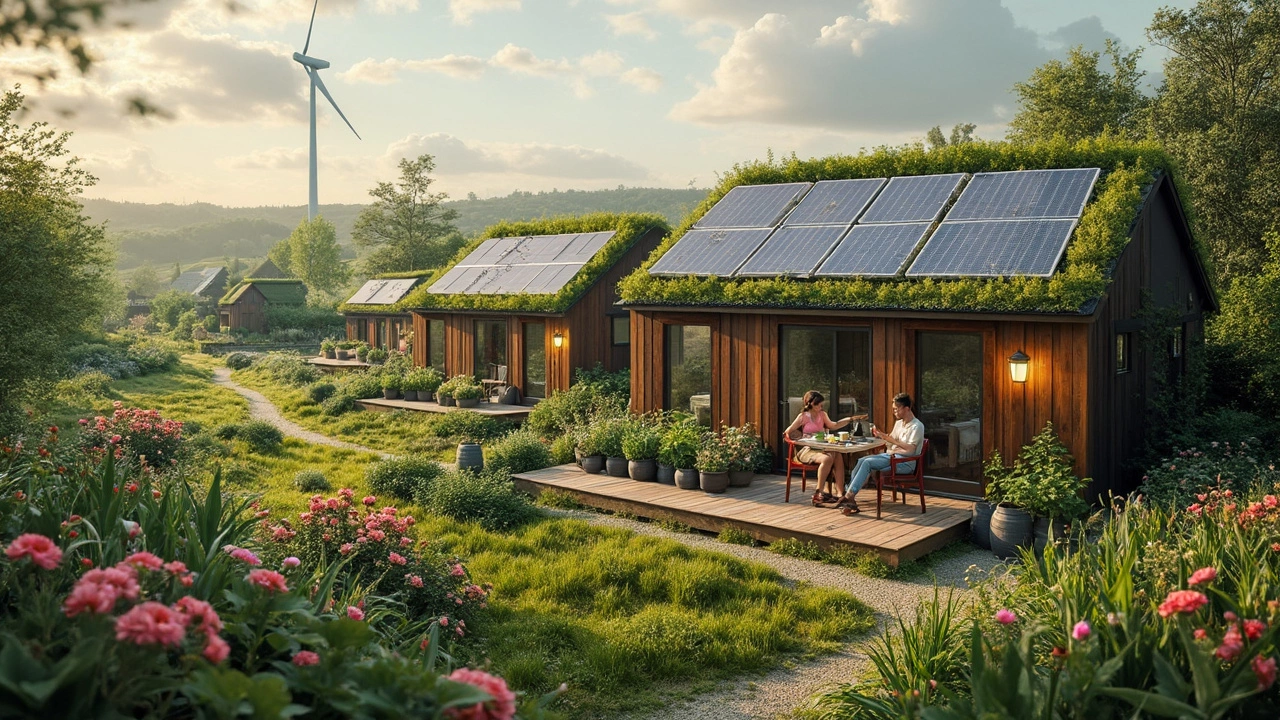People keep asking if tiny houses are just a trend or actually good for the planet. Here’s the truth: shrinking your living space can make a massive dent in your environmental impact. Imagine cutting your electricity, heating, and water bills sometimes by more than half—just because you don’t have as much space to waste energy in.
If you’ve ever felt overwhelmed by the amount of stuff you own, you’re not alone. Tiny houses are built for people who want to live simpler and waste less. Just by swapping a big, traditional home for a tiny one, most folks end up sending way less trash to the landfill every year. And it’s not just about less clutter—smaller homes need fewer building materials from the start, which spares a ton of natural resources.
- Downsized Spaces, Downsized Footprints
- Building Better: Eco Materials and Smart Design
- Energy Efficiency in Everyday Life
- Water, Waste, and Off-Grid Habits
- Practical Tips for Greener Tiny Living
Downsized Spaces, Downsized Footprints
Ever notice how a bigger house somehow always leads to more cleaning, more stuff, and higher bills? Tiny houses flip that script with their small size. The average American home clocks in at around 2,300 square feet, but a tiny house usually sits between 150 and 400 square feet. That’s not just a number to gawk at—it’s key for reducing your footprint.
Less space means you physically can’t stuff your life with as many things. This cuts down on what you buy, what you throw away, and even how much energy you use to run daily life. Smaller square footage uses less electricity for heating, cooling, and lighting. Studies have shown that people in tiny houses often use as little as 10-20% of the energy used in standard homes.
If you’re worried about comfort, here’s the good news: you can still have a cozy home without feeling cramped. Smart layouts, multi-purpose furniture, and better use of vertical space make sure every inch works hard, so you don’t really miss all those empty rooms.
- You’re less likely to hoard things you don’t use.
- Utility bills drop—sometimes savings hit a couple thousand dollars per year.
- You’ll notice a smaller environmental impact when you cut back on stuff and space.
Swapping a big house for a tiny one is like turning down the noise—literally and in your carbon output. You spend less, use less, and end up with more time and money for what actually matters to you.
Building Better: Eco Materials and Smart Design
If there’s one thing tiny houses do well, it’s using fewer resources. When you’re building a small space, every material counts. Lots of builders skip regular drywall or vinyl siding and go for things like reclaimed wood, bamboo, and even recycled metal. These materials take less energy to produce and cut down on waste. For example, bamboo regrows crazy fast—sometimes over three feet in just 24 hours. Reclaimed wood means old barns and factories get new life, and nothing goes to waste.
Insulation isn’t the sexiest topic, but it saves the most energy in your tiny houses. Tiny homes often use sheep’s wool, denim, or rigid foam instead of old-school fiberglass. These choices keep the house warm in winter, cool in summer, and serious money in your pocket by lowering heating and cooling bills.
A lot of smart design tricks help too. Picture big windows letting in a ton of sunlight, so you don’t flip on the lights during the day. Or space-saving features like built-in storage and furniture that folds up or slides away. Thoughtful layouts keep airflow moving, stopping mold and keeping everything feeling fresh.
- Try solar panels—they’re much easier to install on a little roof, and you often need fewer because the whole house uses less power.
- Choose low-VOC paint and finishes. Regular paint can fill tiny spaces with nasty chemicals, but low-VOC or natural paints are safer and better for your lungs.
- Opt for FSC-certified wood. This means it’s sourced from responsibly managed forests, so you’re not adding to deforestation.
Want some data? Here’s a quick look at how using green materials and smart design can really stack up compared to standard homes.
| Feature | Tiny House | Traditional House |
|---|---|---|
| Average lumber needed | Less than 2,000 board feet | More than 16,000 board feet |
| Annual energy required | About 3,000 kWh | Over 12,000 kWh |
| Floor area (sq ft) | Under 400 | Over 2,200 |
So, whether you’re looking at materials or layout, tiny houses prove that you don’t need a lot of space—or stuff—to live well and reduce your impact on the earth.

Energy Efficiency in Everyday Life
Living in a tiny house changes how you use energy every single day—no joke, it’s almost impossible to waste power when your whole place is the size of someone else’s living room. The biggest saver is, plain and simple, less square footage to heat and cool. According to the U.S. Department of Energy, heating and cooling eat up almost half the energy in a regular home. But a tiny house? You can knock that down to a fraction just because there’s not much air to treat.
Good insulation makes a big difference too. Most well-designed tiny houses have thick walls, quality windows, and tight seals. These features stop heat from escaping in the winter and keep things cool in the summer, so you barely need to run a heater or air conditioner.
Appliances in tiny houses are usually smaller and built to use less electricity. Think mini-fridges, induction stovetops, and LED lighting throughout. Many people go for energy-saving upgrades, like:
- Solar panels for off-grid electricity
- Tankless water heaters, which heat water only as needed
- Composting toilets to cut water waste and power use
- Smart thermostats for ultra-precise temperature control
All these choices don’t just save money—they shrink your carbon footprint, too. Even if you plug your tiny house into regular utilities, you’ll use way less energy than in a standard home. And if you want to geek out on energy stats, some folks living tiny have reported slashing their monthly electricity use to just 10-15% of what they used before.
Water, Waste, and Off-Grid Habits
When you live in a tiny house, you notice right away just how much water and waste you actually produce. Most tiny houses aren’t even hooked up to traditional city water or sewer lines, which pushes people to get creative and eco-friendly, fast. Rainwater catchment systems are a game-changer here. These setups let you collect and use rain for everything from showers to watering plants. Some folks filter the water to make it safe for drinking, skipping the need for endless plastic bottles or tapping into municipal water supplies.
Composting toilets are another big win. Forget old-school plumbing—composting loos break down waste naturally without using gallons of water every time you flush. According to the EPA, traditional toilets use about 1.6 gallons per flush. In a year, a family of three could save over 5,000 gallons of water just by switching to a composting model. Plus, the end result can be used safely as fertilizer if processed right, cutting down on chemical use and landfill waste.
- Greywater recycling: Reusing sink and shower water for toilets or garden irrigation is easier in a tiny home. Simple filters can keep your system working smoothly and safely.
- Solar power and small wind turbines: Many tiny houses run off portable solar panels or wind. That means your pump, fridge, and water heater don’t depend on fossil fuels.
| System | Typical Water Use per Year | Potential Savings with Tiny House |
|---|---|---|
| Standard Home (3 people) | 100,000+ gallons | - |
| Tiny House w/ Water-Saving Features | 30,000-40,000 gallons | 60%+ less |
Off-grid doesn’t mean giving up comfort. It’s about using smart tech and a little planning to shrink your environmental footprint. Tiny houses make it simple to kick wasteful habits and start new routines that actually work for you and the planet. Want to keep things really green? Look for low-flow fixtures, LED lights, and energy monitors—these little upgrades help keep your use as light as your footprint.

Practical Tips for Greener Tiny Living
So you’re sold on small-space living, but how do you go from eco-curious to actually making your tiny houses lifestyle even greener? Good news: the best ideas are simple, and anyone can use them—no matter your budget or DIY skills.
The first thing to focus on is energy use. Switching to LED lights cuts energy bills, but you can also go big and install solar panels. Fun fact: a 200-square-foot tiny house often needs fewer than 5 solar panels to be powered completely off-grid, compared to the 15+ panels a normal house needs. If solar isn’t an option, look for ENERGY STAR appliances—they’re proven to use about 10–50% less energy than regular models.
- Insulate your walls and floor—tiny homes lose heat fast if you skimp here. Sheep's wool and recycled denim batts are both eco upgrades.
- Use a composting toilet. These save about 6,800 gallons of water per person every year. That’s not just good for your bills—it’s huge for water conservation.
- Install a rainwater catchment system. For much of the U.S., a 100 square foot roof can capture up to 60 gallons of water from just one inch of rainfall. Perfect for watering plants or flushing toilets.
Minimizing waste is the next step. Tiny house dwellers find they buy less, but you can go further:
- Shop for secondhand or reclaimed building materials. Not only are you saving money, but you’re preventing more stuff from ending up in the landfill.
- Choose furniture with more than one use—think beds with storage drawers or tables that fold away. This helps you keep only the things you need.
Finally, get creative outside. Native gardens need less water and attract pollinators. If space allows, a small container garden supplies fresh veggies and cuts down on trips to the store. Every bit helps.
| Action | Resource Savings Per Year |
|---|---|
| Composting Toilet | ~6,800 gallons of water |
| LED Lighting vs. Incandescent | 75% less electricity |
| Energy Star Appliances | 10–50% less energy |
| Rainwater Harvesting (100 sq ft roof) | Up to 60 gallons per 1" rain |
Eco-friendly tiny living isn’t about being perfect—it’s about small, smart decisions that add up to a big difference. Try out one or two of these tips, see what fits your life, and pretty soon you’ll see just how easy green living can be in a tiny space.
